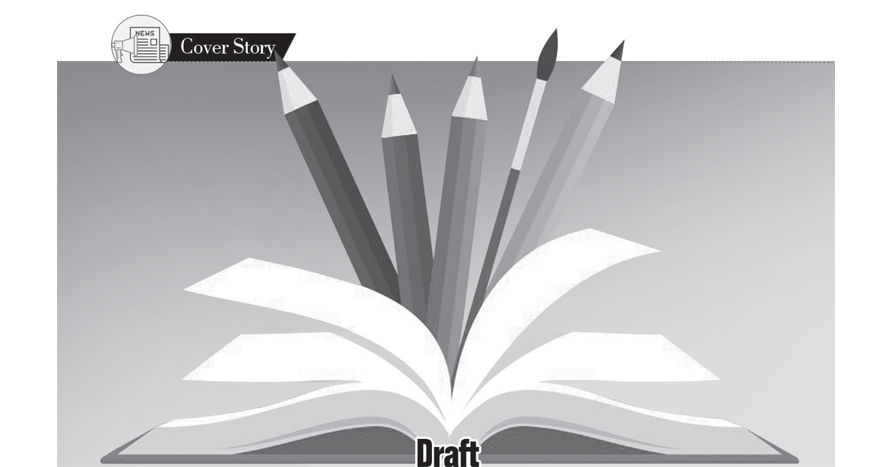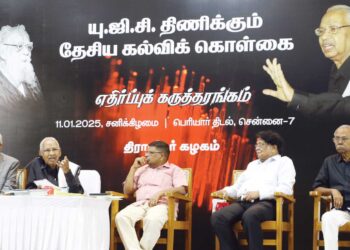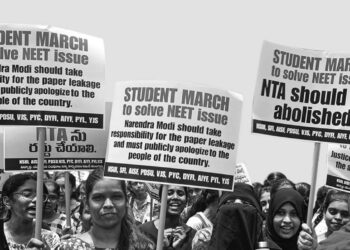Sanatana (a)dharma discriminated people by birth and denied eduction to the major sections.In the awakened era of social justice eduction cannot be denied, but discrination in getting educated is attempted under the guise of National Education policy
K.Veeramani
The Draft National Education Policy 2019 submitted by K. Kasturirangan, former Chairman, ISRO (Indian Space Research Organization) has been released by the BJP led NAD government as a major policy pronouncement after assuming the power at the Centre in June 2019. The report is the follow up for the execution of the earlier report furnished under the chairmanship of T.S.R. Subramanian, former Cabinet Secretary, Government of India. The release of the draft policy is coupled with the appeal inviting suggestions from the public for its receipt on or before 30th June 2019 later extended to 31st July 2019.
The basic flaw in the formation of the Committees is their Chairmanships and their composition. Neither of them is an educationist nor exposed to the teaching and executive experience in the field; whereas the earlier two commissions formed after the Iindependence of the country were chaired by renowned scholars cum educationists, Dr. S. Radhakrishnan and Prof. Dr. S. Kothari.
The formation of the committee and the way and time limit given by the MHRD (Ministry of Human Resource Development) for suggestions itself show the unilateral intention of the saffron rulers to implement their Hindutva agenda in the already decided line which was their practice during the earlier regime too.
During the Modi regime I (2014-2019) sufficient spade work had been carried out by changing the curriculum in the schools and colleges, providing space for the mythical characters of Vedic age and culture by glorifying the puranas and ithikasas as value education. The heads of the various higher educational bodies were filled with saffron ideologue or personnel ready to act as per the wishes of the saffron rulers.
The draft Policy stipulates a new structural pattern in the educational system, the requirement of which is very much questionable.
School Education: At present 10+2 system prevails in High School education. The draft Policy prescribes 5+3+3+4 system from the age of 3 to 15 years. Now the formal education starts from 1st standard at the age of 5 years. Instead as per the new proposal, it starts from the age of 3 years to 8 years during the first stage, then above 8 years upto 11 years in the second stage completing 5th standard. Above 11 years upto 14 years it covers 6th to 8th standard. Finally above 14 years upto 18 years, the students would undergo study in the 9th to 12th standards . For a country like India, wherein education was denied to the major sections in the society historically, commencing education at the age of 3 years may appear a progressive one. The gap in educational environments at school and at the family circles is almost nil for the sections which had been a monopolised education historically. From that hierarchy, the gap expands in the first generation, second generation and so on educated families and it becomes very wide in rural areas where the parents of the students would be either illiterate or not even completed the primary education.
The tactical prescription of the Policy lies in conducting tests to identity the learning skill of the student at the level of 3rd, 5th and 8th standards. Segregation and discrimination among the students start from this level! Which category of students can fair well in such sort of tests? Only the students from the family where the learning environment gap is minimal can do well. The students hailing from the families where the gap is wide cannot do so for the historical reasons. By branding such students as possessing low learning skill . the future of their study would be decided, in fact finished.
It is nothing but annihilating the future of the students whose families were denied education for so many centuries. Automatically such students would be forced in an implied manner to discontinue their education and leave seeking profession carried out by their families. This was what the Sanatanic (a)dharma advocated and implemented in the society as a way of life, so to say ‘divine life’. It was called kula dharma. What was to be practised as ‘kulakalvi’, eradicated by the uprisal and the severe opposition exerted by Periyar, again raises its head through National Education Policy. It is only a regressive measure for the education of the marginalised and underprivileged sections that has been offered with progressive sugar coating like formal education starts at the age of 3 years.
This cunning tactics in offering education continues as the students proceed further. From 9th standard upto 12th standard, it is considered as intermediate education compartmentalised into 8 semesters, the examinations for which would be conducted by the educational board either of government or private.
Examination Boards: Filtering the students by conducting examination at the level when they are not aware of their education at all is projected as a progressive step in the Policy. This so called progressive process of conducting examination has been delegated to the private sector, with the formal approval of the government. When examinations are conducted by the government boards, a lot of malpractices are happening which could be controlled and set right. But if it is private sector, the scope for the malpractices will be enormous. Further the choice of examination boards either government or private is vested with the concerned school authorities.
Collegiate Education: The hurdles for free furtherance of studies is not limited to school level and it continues while entering the collegiate education too. Even after passing through 15 years study at school level by undergoing various examinations, the marks obtained are not sufficient to get admission in college. Again the candidates who have to appear for entrance tests and that will decide the admission. National Testing Agency (NTA) will conduct the entrance cum eligibility test to all degree courses including B.A., B.Sc., B.Com., etc.
Sanskrit Imposition: Language learning and medium of learning through a particular language are the major educational loads on students. The ultimate medium of learning must be through the mother tongue of the students which will enable for free flow in thinking, analyzing and to contribute constructively. Nothing has been mentioned in the Education Policy about the medium of learning by students both at school and collegiate levels.
On language learning front, the imposition of Hindi and Sanskrit is invariably included as if it is imperative for education. Language is not knowledge; it is the medium through which acquiring of knowledge (subjects) takes place. Besides, learning a language apart from mother tongue is a very difficult task. The opportunity benefit of acquiring knowledge is more than learning an additional language. But in practice learning of Regional Language is becoming a must for socio political reasons and for many both mother tongue and regional language are one and the same.
Today the purpose of getting educated is mostly oriented towards getting employment. So learning one additional language apart from the regional language is required and in the present context it has to be necessarily English. It has to be learnt by all for the availability of most of the curriculum texts in English and for the scope of getting employment invariably throughout the world. Apart from the regional language and English, learning of Hindi and Sanskrit language are imposed in the Education Policy. Sanskrit is prescribed as an elective subject invariably at all levels in school and college education. Hindi is prescribed as compulsory third language. Immediately after the release of the draft Policy, opposition to the imposition of Hindi as compulsory, erupted from Tamil Nadu, the Land of turbulent history against Hindi imposition. The government withdrew the prescription of learning Hindi as compulsory language subject, but stick to the three language policy of one more language learning apart from the regional language and English. The compulsory learning of Hindi has come down to the level of its learning by default. Hindi would be one of the languages along with Sanskrit, French, Germany, and Russian as the case may be. When the third language learning is compulsory automatically the choice would go in favour of Hindi for non Hindi speaking people. Learning an additional language apart from the regional language and English is not at all warranted. It will add to the educational load of students at the cost of acquiring knowledge in various updated academic subjects. The compulsory three language formula advocated in the Education Policy is nothing but a strategic move to force the students to learn Hindi or Sanskrit, the inner core ideology of Hindutva.
Usurping the Power of State Governments: When Constitution was framed, its founders, by reckoning the varied cultural, socio political conditions of the country, placed the subjects ‘Education’ under ‘State List’ of the Constitution giving exclusive domain to the respective State Government.
Later the subject was shifted to ‘Concurrent List’ both the Centre and the State can concur over any issue on education and act upon.
But during the past the Union government has unilaterally acted on most of the matters related to education, with its power by introducing NEET When voices from the States are getting intense to bring back the subject, ‘Education’ from the ‘Concurrent List’ to the ‘State List’, to ensure the federal features as enunciated in the Constitution. The draft National Education Policy 2019 has made drastic changes as if the subject ‘Education’ is in ‘Union List’, the exclusive domain of Central Government. Of course, it may be the will of the saffron rulers to bring the polity of the country ‘unitary’, which they already started as ‘One nation, One election’, ‘One nation One ration card’ plan etc.
The released draft National Education Policy 2019 aims for the fundamental principle of ‘One nation, one language’ with favouring factors leading to their ultimate goal of ‘One nation, One religion’. The game plan of one religion is nothing but Hindutva.
Let the opposition to the draft National Education Policy 2019 mount enormously by bringing the consequences of the agenda in public domain through debate and discussion and make the public realise the danger posed to the current generation and posterity!









